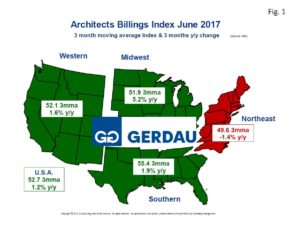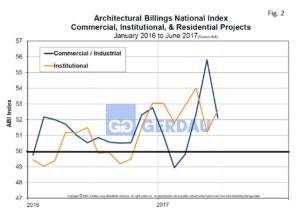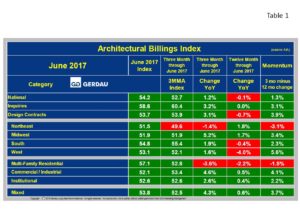Architectural Billings Index
The national ABI score for June was 54.2, up 2.2 points above May’s score, (> 50 indicates an increase in billings). The ABI has been greater than 50 for five of months in a row and for nine of the last 12 months. The new projects inquiry index was 58.6, down 3.8 points month on month.
All four regions of the country reported expanding billings in June. The South recorded the strongest score at 54.8, followed by the West at 53.1 and the Midwest at 51.9 and the Northeast reported a score of 51.5, rebounding from last month’s score of 49.6.
 Figure 1 presents a map of the US depicting the four ABI regions. It is color coded to show expanding billings and increased growth in green and declining billings and negative growth in red. The data is shown on this map is as three month moving averages (3MMA), and 3 month year on year (y/y), percent change. On a 3MMA basis, the US ABI score was 52.7 with a 1.2% growth y/y. The Southern zone scored the highest 3MMA ABI with 55.4. Its growth rate was 1.9% y/y. The Midwest recorded a 51.9, 3MMA ABI and the strongest y/y growth rate at 5.2%. The West recorded a 3MMA of 52.1 and a 1.6% y/y growth rate. The Northeast posted a 49.6 3MMA ABI, and negative 1.4% y/y growth.
Figure 1 presents a map of the US depicting the four ABI regions. It is color coded to show expanding billings and increased growth in green and declining billings and negative growth in red. The data is shown on this map is as three month moving averages (3MMA), and 3 month year on year (y/y), percent change. On a 3MMA basis, the US ABI score was 52.7 with a 1.2% growth y/y. The Southern zone scored the highest 3MMA ABI with 55.4. Its growth rate was 1.9% y/y. The Midwest recorded a 51.9, 3MMA ABI and the strongest y/y growth rate at 5.2%. The West recorded a 3MMA of 52.1 and a 1.6% y/y growth rate. The Northeast posted a 49.6 3MMA ABI, and negative 1.4% y/y growth.
Figure 2  charts the ABI sub-index for Commercial / Industrial and Institutional from 2016 to present. The Commercial/Industrial sub-index moved-up 0.3 points to 52.1 in June as the private construction sector continued to gain strength. The index has been greater than 50 for 17 consecutive months. The Institutional scored a 52.6, its eighth month in a row greater than the 50. New design contracts fell by 1.1 points month on month, still well above the 50 threshold with a score of 53.7.
charts the ABI sub-index for Commercial / Industrial and Institutional from 2016 to present. The Commercial/Industrial sub-index moved-up 0.3 points to 52.1 in June as the private construction sector continued to gain strength. The index has been greater than 50 for 17 consecutive months. The Institutional scored a 52.6, its eighth month in a row greater than the 50. New design contracts fell by 1.1 points month on month, still well above the 50 threshold with a score of 53.7.
 Table 1 lists the overall ABI and all of its sub-indexes. It presents and compares monthly and 3MMA data, showing percentage point change on both three and 12 month basis, as well as momentum. Green denotes positive change, while red indicates negative growth. Concerns are the Northeast with negative momentum. Multi-family residential also recorded negative momentum as well as slower growth for both three months and 12 month y/y comparisons. Overall the ABI report was very encouraging.
Table 1 lists the overall ABI and all of its sub-indexes. It presents and compares monthly and 3MMA data, showing percentage point change on both three and 12 month basis, as well as momentum. Green denotes positive change, while red indicates negative growth. Concerns are the Northeast with negative momentum. Multi-family residential also recorded negative momentum as well as slower growth for both three months and 12 month y/y comparisons. Overall the ABI report was very encouraging.
Construction employment increased by 16,000 jobs in June to the highest level since October 2008. This was close to double the hiring rate of the overall economy as construction firms ventured outside the industry to locate workers. Construction firms added 206,000 workers or 3.1% y/y vs. 1.6% for total nonfarm payroll employment. Going forward it will become increasingly difficult to find skilled workers as the economy approaches full employment.

